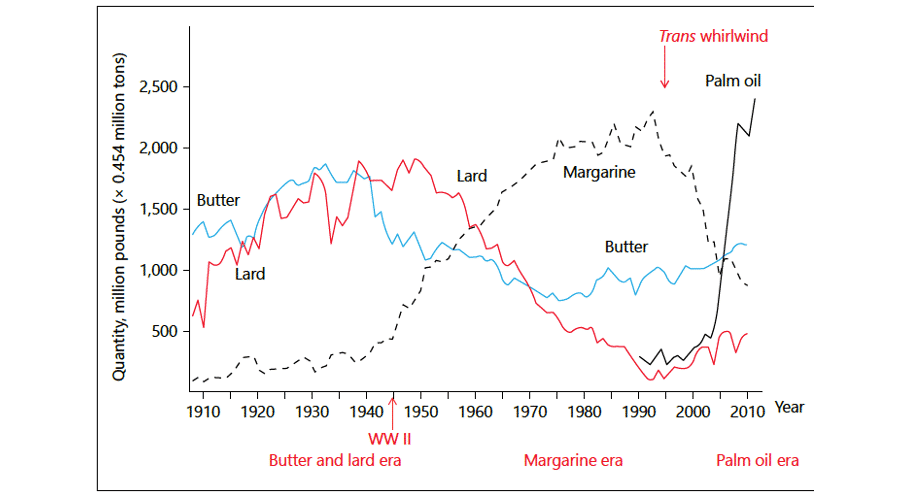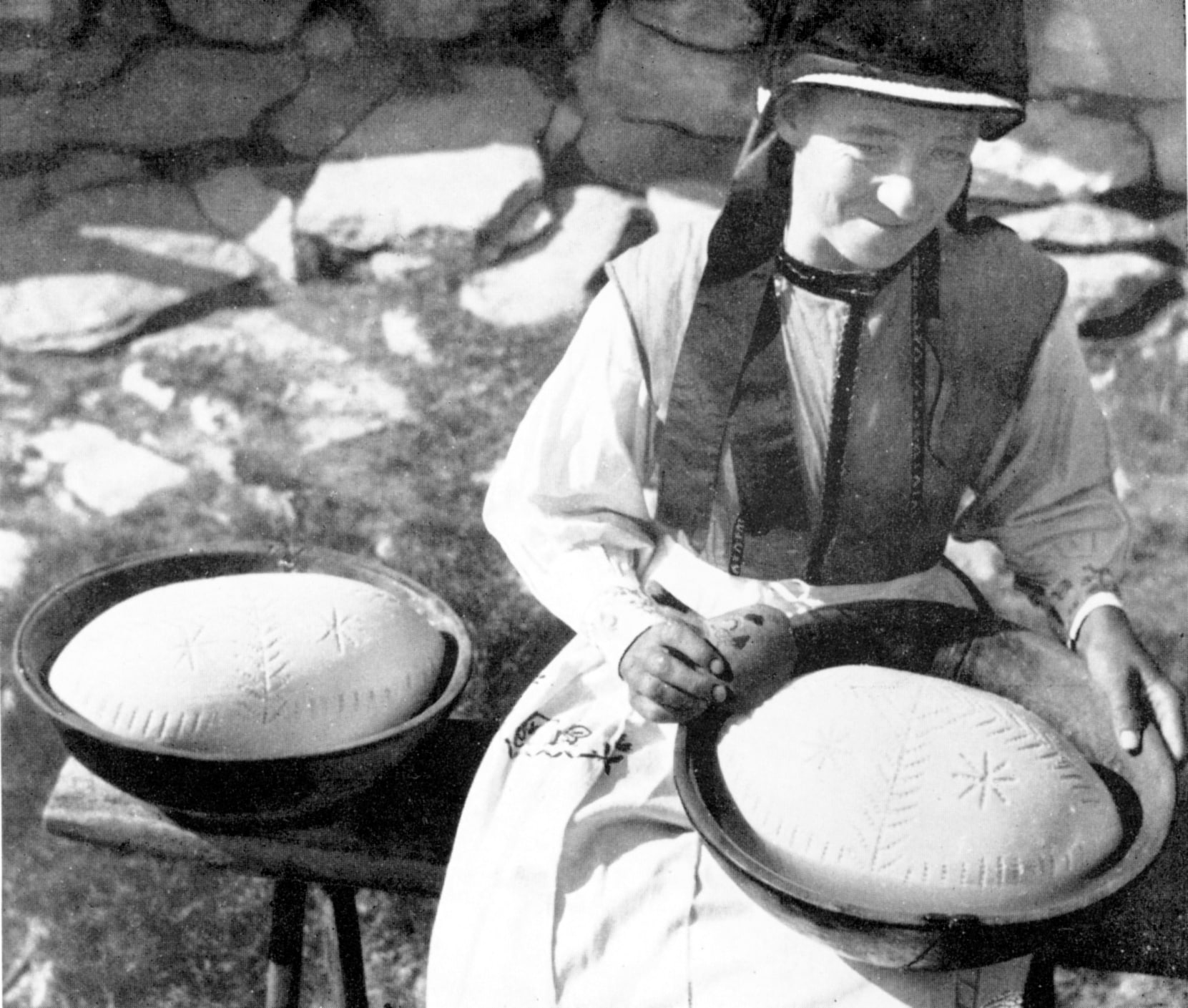Take home message
- Oil from palm oil does not belong in the diet of cows. Even though a limited amount of palm oil is beneficial for milk and milk fat production and therefore the farmer’s wallet, the fatty acid composition shifts in an undesirable direction, far from what we see, in milk fat when cows eat only fresh grass.
- Conjugated linoleic acid (CLAc9t11) and alpha-linolenic acid (ALA C18:3) will be reduced, when palm oil is fed.
Changing dietary fat
Due to (mis)interpretation by nutrition researchers like Ancel Keys (1904-2004), in the 1950s and 1960s, our fat consumption changed dramatically. Mortality from cardiovascular disease among middle-aged white American men was the main reason for looking at the consumption pattern of modern, Western men. In the background a battle of the sugar industry and the fat industry was present, and one had to get the Black Peter. The fat industry lost and in a few decades our diet was ‘improved’: animal fat (butter, lard) was seen as the big culprit of fatty deposits in the arteries of these men and the simple slogan became ‘eating fat makes you fat’. (Animal) fat had to be taken out of the diet. The hype around cholesterol levels in the blood have contributed to the fact that nowadays many people go on pills early to keep these levels artificially low (see Kendrick, 2008).
However, health has unfortunately not improved. Fat was replaced by sugars and in particular fructose, which had a detrimendous effect on health. Gradually, we have all become obese and suffer from metabolic syndrome, including immunological problems that start in the fat cells of white storage fat tissue.
Our ancestors lived on animal fat: pork fat and the fat of cattle, subcutaneous, around the kidneys, etc, called lard and tallow. In addition, there was butter from milk fat. Anno 2020, we live in an era of vegetable oils, diet margarine enriched with omega-3 fatty acids and the rise of vegetarianism and veganism. Fat and especially animal fat has gotten a bad name. A major source of vegetable oil is palm oil. Huge tropical plantations arose to meet world demand for palm oil, at the cost of a lot of rainforests.
British Dutch multinational Unilever started producing margarine early on. There was a need for a cheap, spreadable fat as an alternative to animal fat, which was not always available to the growing world population. In the graph below (based on figures from the USDA, it is easy to see, how over the past century our fat consumption and our fat sources changed. We are now in the palm oil era, which has become the main source of fat since the beginning of the 21e century. Shortly before the turn of the century, the graph shows an arrow with ‘trans whirlwind’. This refers to the negative outcomes on health of the so-called trans fatty acids, which were created during the hardening process of plant oil. A high proportion of C18:1t9 (elaidinic acid) and C18:1t10 is formed. These fatty acids were negatively correlated with health and en passant included in their public impact the major trans fatty acid in milk fat (C18:1t11). Cows produce trans-vaccenic acid (C18:1t11) from fresh grass, which is a direct precursor of CLA (C18:2c9t11). Meanwhile, a differentiation is made between industrial trans fatty acids (i-trans) and animal trans fatty acids (r-trans from ruminants). The first group has a negative impact on health, the second a positive one. The insight into the negative impact of i-trans fatty acids has led to adjustments in the margarine production process and these i-trans fatty acids are now prevented from ending up in margarine.

Palm oil
The origin of palm oil remains debatable, due to its impact on the rainforest. Oil from palm seed has a big advantage when it comes to frying and roasting: it is high in saturated fat, in this case palmitic acid (C16:0). People from India developed the storable Ghee, made from butter, and like lard, long-lasting, and our ancestors did not hesitate to fry in lard or tallow. The belly fat of pigs was eaten with relish and consisted (like the oil from pam) mainly of saturated fat, in this case stearic acid (C18:0).
Palm oil in animal feed
If you watch videos of the Malaysian palm oil industry, the uses of palm oil are immense, including in our cows’ feed. Cows need fat too, and when they graze, large amounts of the unsaturated alpha-linolenic acid (ALA-n3 = C18:3c9c12c15) from grass chlorophyll are eaten. Linoleic acid (LA-n6 = C18:2c9c12) is also an important source of polyunsaturated fat. Both fatty acids are essential and serve as a start for reprocessing into even longer chains of polyunsaturated fatty acids, the so-called fish fatty acids. A lot of both fatty acids are broken down in the cow’s rumen and become saturated. Among other things, this creates stearic acid (C18:0). To increase the milk production, experiments with palm oil feeding have been conducted.
Researchers assessed the effect of palm oil in dairy cattle rations (Mosley et al., 2007). Four groups of cows with increasing amounts of palm oil in the ration were compared, both in terms of milk production, fat content, but also milk fatty acid composition. Table 1 shows that the amount of oil intake was slightly lower than planned, but the differences between the groups are clear. The 500-group shows that palm oil leads to a higher feed intake of the cows, but higher amounts of oil (1000 and 1500) showed, that the cows started to dislike their feed. So, there is a favourable effect of the first 500 grams; above that, there are no or only small differences.
Table 1. Palm oil added to dairy cattle rations, intake and production of milk (in cows per day)
| Target palm oil amount (grams) | 0 | 500 | 1000 | 1500 |
| Realised intake of palm oil (grams) | 0 | 476 | 887 | 1248 |
| Dry matter (kg) | 23,3 | 26,4 | 24,7 | 23,8 |
| Milk (kg) | 30,9 | 34,0 | 34,2 | 34,2 |
| Fatt (%) | 3,44 | 3,93 | 4,06 | 3,88 |
| Protein (%) | 2,98 | 2,97 | 2,94 | 2,90 |
| Fat (grams) | 1018 | 1304 | 1320 | 1411 |
Palm oil had a marked effect on the composition of milk fat, measured in fatty acid composition (Table 2).
Table 2. Single fatty acids in the milk fat of four groups of cows with increasing amounts of palm oil in the ration. The control group is shown absolutely, the three experimental palm oil groups as a ratio to the zero group (in per cent).
| Target palm oil amount (grams) | 0 | 500 | 1000 | 1500 |
| C14:0 (myristin acid) | 9.8 | 88% | 81% | 81% |
| C16:0 (palmitic acid) | 30.7 | 127% | 143% | 148% |
| C18:0 (stearin acid) | 9.1 | 75% | 63% | 54% |
| C18:1c9 (oil acid) | 21.2 | 91% | 84% | 82% |
| C18:2c9c12 (LA-n6) | 3.59 | 88% | 83% | 87% |
| C18:3c9c12c15 (ALA-n3) | 0.50 | 82% | 72% | 72% |
| LA / ALA | 7,2 | 108% | 116% | 120% |
| (C14:0 + C16:0) / C18:1c9 (squizability) | 1.9 | 130% | 152% | 161% |
| C14:0 + C16:0 – C18:0 – C18:1c9 (squizability) | 10.2 | 213% | 279% | 307% |
| CLAc9t11 () | 0,46 | 87% | 74% | 65% |
| Saturated FA | 65,5 | 104% | 107% | 107% |
| MUFA | 28,5 | 93% | 88% | 87% |
| PUFA | 5.96 | 87% | 79% | 80% |
There are some notable outcomes. When the amount of palm oil in the ration increases, it also increases in the milk fat production (30-40% more total gram fat/day). Normally the fatty acids present in the cow’s feed are completely broken down into short-chain fatty acids (C2:0, C3:0 and C4:0), which are then rebuilt in the udder into new long-chain fatty acids. However, not the palm oil, which bypasses this breakdown to enter the milk directly from the small intestine. The increase in palmitic acid comes at the expense of stearic acid (C18:0), which is formed less in the udder. Hand in hand the major unsaturated fatty acids (oleic acid, CLA and alpha-linolenic acid) decrease with the increase of palm oil in the diet. Overall, the proportion of saturated fat increases and the proportion of monounsaturated and polyunsaturated fatty acids decreases with the increase of palm oil in the cow ration
Squizing a packet of butter
Both in the analyses of butter or milk fat, as shown in Table 2, the quality of the fat decreased after feeding palm oil. Recently, more and more comments about the firmness of today’s butter are emerging in Canada and elsewhere. Every butter consumer knows the difference between yellow grass butter and pale winter butter or between yellow cheese from grass and pale firm cheese from a winter diet. In The Netherlands, it is even advertised, along the lines of ‘it’s here again: grass cheese’ in combination with the spring moment that cows get again access to pasture.
Ultimately, it is the shift in saturated and unsaturated fat that determine whether butter is spreadable at room temperature or still firm in consistency. With the increase in unsaturated fat, spreadability increases, the butter is softer. The colour changes mainly because the cows also excrete the beta-carotene from grass, which makes the cheese and butter, yellow to even orange in colour. Palm oil in the diet of cows, however, results in large amounts of saturated fat as palmitic acid in the milk fat (or butter fat, or cheese fat) and the desired polyunsaturated fatty acids are strongly reduced. Palm oil turns butter and cheese into the extreme of a stable cheese or stable butter. Butter with so much palmitic acid starts to resemble the hard palm fat itself.
Literature
- Bonner, J. (2012). From pork lard to palm oil and back. Nature, 492(7427), 41-41.
- Kendrick, M. (2008). The great cholesterol con: the truth about what really causes heart disease and how to avoid it. Kings Road Publishing.
- Mosley, S. A., Mosley, E. E., Hatch, B., Szasz, J. I., Corato, A., Zacharias, N., … & McGuire, M. A. (2007). Effect of varying levels of fatty acids from palm oil on feed intake and milk production in Holstein cows. Journal of Dairy Science, 90(2), 987-993.
- Staniewski, B., Ogrodowska, D., Staniewska, K., & Kowalik, J. (2021). The effect of triacylglycerol and fatty acid composition on the rheological properties of butter. International Dairy Journal, 114, 104913.
Foto: farm woman in the Swiss Lötschen-valley making butter for trading purpose (start 20th Century)




